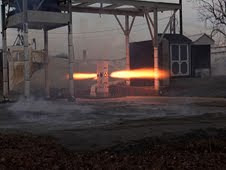 On Tuesday, Dec. 15, NASA, Alliant Techsystems (ATK) and Lockheed Martin celebrated a major milestone with a ground test of a full-scale attitude control motor (ACM) for the Orion crew exploration vehicle’s launch abort system (LAS).
On Tuesday, Dec. 15, NASA, Alliant Techsystems (ATK) and Lockheed Martin celebrated a major milestone with a ground test of a full-scale attitude control motor (ACM) for the Orion crew exploration vehicle’s launch abort system (LAS).+ View low-angle video
+ View high-angle video
+ View images
"The completion of the Demonstration Motor 1 hot-fire test is a substantial advancement in developing the ACM," said LAS Manager Kevin Rivers, of NASA’s Langley Research Center in Hampton, Va. "With an elaborate eight-valve control system that relies on advanced ceramic composites for several key components, the ACM is among the most complex solid rocket systems ever built."
The test performed at ATK’s facility in Elkton, Md., was the sixth in a series of ground tests of Orion’s attitude control motor system. The ACM is charged with keeping the crew module on a controlled flight path after it jettisons, steering it away from the Ares 1 crew launch vehicle in the event of an emergency, and then reorienting the module for parachute deployment.
Having reached this milestone brings Constellation another step closer to flight-ready status and demonstrates progress toward improved flight safety for astronauts, which is at the core of Constellation Program success.
The launch abort system, mounted on top of the Orion crew module, centers around three solid propellant rocket motors: an abort motor, an attitude control motor; and a jettison motor. Successful tests of both the abort and jettison motors were completed in 2008. The attitude control motor consists of a solid propellant gas generator, with eight proportional valves equally spaced around the outside of the 32-inch diameter motor. Together, the valves can exert up to 7,000 pounds of steering force to the vehicle in any direction upon command from the crew module.
"Controllable solid rockets have only recently begun seeing application in spacecraft, and the ACM delivers an order of magnitude greater thrust than any of those systems," said Rivers. "It represents a significant technical advancement in controllable solid propulsion."
Testing wouldn’t be possible without the support and hard work from the ATK, Lockheed Martin and NASA LAS teams.
"There are many dedicated people from across the nation who have worked diligently to overcome technical challenges to make the test happen,” said Rivers. “I am proud of each of them."
The entire launch abort system will be demonstrated during a Pad Abort 1 flight test at the U.S. Army’s White Sands Missile Range (WSMR) in New Mexico in the spring of 2010.
The attitude control motor for the flight test is scheduled to be delivered to WSMR in January, followed by the stacking of the launch abort system.
Langley manages the launch abort system design and development effort with partners and team members from NASA’s Marshall Space Flight Center in Huntsville, Ala. Langley’s Launch Abort System Office performs this function as part of the Orion Project Office located at NASA’s Johnson Space Center in Houston. ATK is under contract with Lockheed Martin, NASA’s prime contractor for Orion, to develop and test the attitude control motor.
View this site car shipping car transport auto transport auto shipping




No comments:
Post a Comment